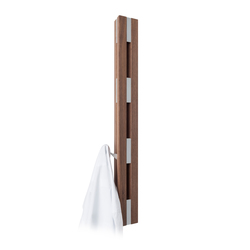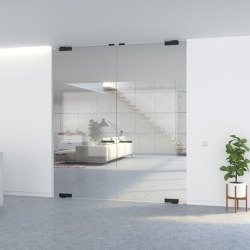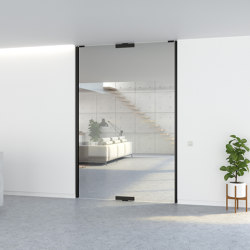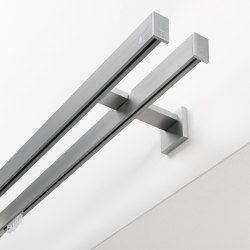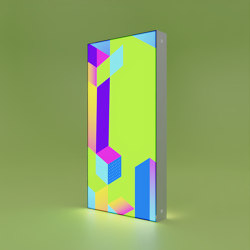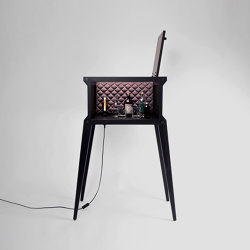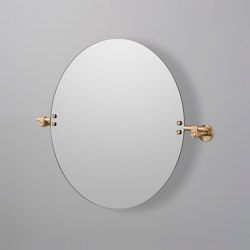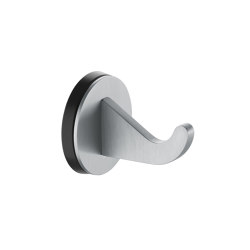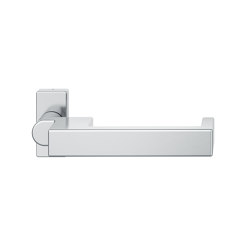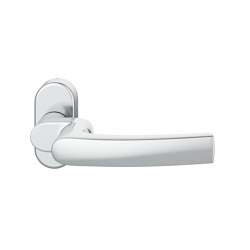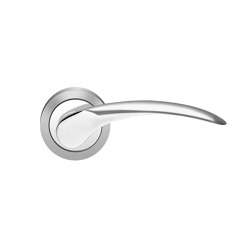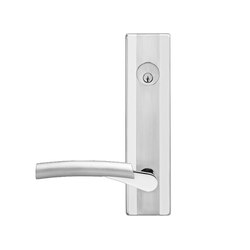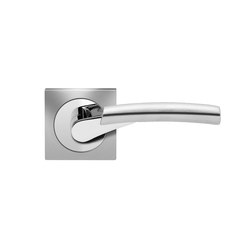Sobre Olivari
DESCUBRE MáS SOBRE OLIVARI
A HUNDRED YEARS OF OLIVARI DOOR HANDLES
1911-1960
Throughout the 100-plus years of its manufacturing history, Olivari has earned distinction for the quality of its products and the reputation of its brand. From generation to generation, the Olivari family has passed down the attention for detail, the quest for innovation, and above all, a passion for working to high standards.
In 1911, Battista Olivari founded the company in Borgomanero, Novara, where the factory is still located, and where the entire production process of the handles still takes place today.
In 1926, Battista’s wife Antonietta Ramelli took over the helm of the family business. She was one of the first women in Italy to head a company, making her a pioneer of female entrepreneurship.
In the 1930s, the company began its first collaborations with the two most important Italian architects at the time, Marcello Piacentino and Gio Ponti.
After World War II, the company, now led by the brothers Ernesto, Ambrogio and Luigi, contributed to the reconstruction, working side by side with the masters of Italian architecture: Franco Albini, Ignazio Gardella, Angelo Mangiarotti and BBPR. Work relations with Gio Ponti intensified. The handles they custom designed for their new buildings were highly elegant and inventive objects that became fixtures of the Olivari range, and some are still in production.
1960-1990
In the 1960s, incessantly searching for new design solutions, Olivari began working with the protagonists of the nascent Italian design scene, establishing solid relations with Sergio Asti, Luigi Caccia Dominioni, Joe Colombo, Monti GPA, Marcello Nizzoli and many others whose handles were added to the catalogue.
On the industrial side, the company decided it needed a new, more extensive production plant with cutting-edge die-casting machinery to rise to the challenge of a growing market.
The designers’ visionary, futuristic ideas and the stimulating work environment this created led to formally and technically innovative handles. Bica, the first anodised aluminium handle, came out in 1959. Boma, the first plastic handle, was launched in 1970. Both rapidly became best-sellers, bolstering the design world’s esteem for the company’s reputation.
In the 1980s, the third generation of the Olivari family progressively came to the fore. The brothers Antonio, Giovanni, Giuseppe, Carlo and Enrico were the company’s new blood, and they forged ahead with design-related and technological evolution.
1990-2010
The 1990s were distinguished by the fruitful collaboration with Alessandro Mendini, who promoted the public appreciation of the company’s historical heritage. He encouraged the brothers to tell their manufacturing story in the book L’architettura presa per mano. La maniglia moderna e la produzione Olivari.
New prestigious contacts arrived with Vico Magistretti, Andrea Branzi, Richard Sapper, Paolo Portoghesi, Oscar Tusquets and Massimo Iosa Ghini, with whom the company established enduring bonds of friendship and design exchange.
At the same time, the technique of hot forging was introduced, and in a few years’ time it substituted die-casting entirely.
The 2000s offered the opportunity for another expansion of the production capabilities. In addition to the full control over the industrial cycle by encompassing all processing phases inside the company, components included, investments were made in highly automated manufacturing techniques, organised according to the most advanced technological insights.
Research on innovative, more sustainable finishes resulted in Biocromo and SuperFinish, with very elevated performance factors and respect for the environment.
Olivari proceeded to follow its vocation for dialogue with the world of design and architecture. Exchange with the most famous designers on the Milan scene – Enzo Mari, Rodolfo Dordoni, Piero Lissoni, James Irvine and Patricia Urquiola – was flanked by collaboration with the great maestri of contemporary architecture – Shigeru Ban, Steven Holl, Toyo Ito, Daniel Libeskind, Peter Marino and Dominique Perrault.
Olivari’s internal technical department presented the results of a study based on the geometric figure of the square. These handles were launched to great commercial success and acclaimed for their novelty.
2010-2017
The 2010s, and here we have arrived at present times, were opened with the celebration of Olivari’s first 100 years of business. The book Macchina semplice. Dall’architettura al design. 100 anni di maniglie Olivari was presented in Venice at the headquarters of the Architecture Biennale, which holds symbolic meaning for the company. The Biennale was also the occasion to introduce the first nucleus of the future Olivari Museum. Contemporaneously, construction began on the company’s new office wing, and the 100th anniversary was marked by high-impact displays at the Milan Furniture Fair and the Triennale di Milano.
As for communication, the renewal of the company’s entire visual identity was undertaken. As for production, a new category of components was introduced, its aim being to make new Olivari handles even more modern and elegant by miniaturising the internal elements and mechanisms. New collaborations with international architects and designers were started. Handles by Zaha Hadid, Jean Nouvel, Ben van Berkel, Rem Koolhaas, Marcel Wanders, Ma Yangsong and Ron Gilad were added to the Olivari range.
Over the course of the last two years, Olivari has started two new lines of research. On the cultural and historical side, there is the collection Guilloché, featuring special surface decorations that embellish the handles. On the technological side, there is the series of new Super finishes, which offers designers and discerning customers ulterior expressive possibilities. This is 2019. Our research continues…
A HUNDRED YEARS OF OLIVARI DOOR HANDLES
1911-1960
Throughout the 100-plus years of its manufacturing history, Olivari has earned distinction for the quality of its products and the reputation of its brand. From generation to generation, the Olivari family has passed down the attention for detail, the quest for innovation, and above all, a passion for working to high standards.
In 1911, Battista Olivari founded the company in Borgomanero, Novara, where the factory is still located, and where the entire production process of the handles still takes place today.
In 1926, Battista’s wife Antonietta Ramelli took over the helm of the family business. She was one of the first women in Italy to head a company, making her a pioneer of female entrepreneurship.
In the 1930s, the company began its first collaborations with the two most important Italian architects at the time, Marcello Piacentino and Gio Ponti.
After World War II, the company, now led by the brothers Ernesto, Ambrogio and Luigi, contributed to the reconstruction, working side by side with the masters of Italian architecture: Franco Albini, Ignazio Gardella, Angelo Mangiarotti and BBPR. Work relations with Gio Ponti intensified. The handles they custom designed for their new buildings were highly elegant and inventive objects that became fixtures of the Olivari range, and some are still in production.
1960-1990
In the 1960s, incessantly searching for new design solutions, Olivari began working with the protagonists of the nascent Italian design scene, establishing solid relations with Sergio Asti, Luigi Caccia Dominioni, Joe Colombo, Monti GPA, Marcello Nizzoli and many others whose handles were added to the catalogue.
On the industrial side, the company decided it needed a new, more extensive production plant with cutting-edge die-casting machinery to rise to the challenge of a growing market.
The designers’ visionary, futuristic ideas and the stimulating work environment this created led to formally and technically innovative handles. Bica, the first anodised aluminium handle, came out in 1959. Boma, the first plastic handle, was launched in 1970. Both rapidly became best-sellers, bolstering the design world’s esteem for the company’s reputation.
In the 1980s, the third generation of the Olivari family progressively came to the fore. The brothers Antonio, Giovanni, Giuseppe, Carlo and Enrico were the company’s new blood, and they forged ahead with design-related and technological evolution.
1990-2010
The 1990s were distinguished by the fruitful collaboration with Alessandro Mendini, who promoted the public appreciation of the company’s historical heritage. He encouraged the brothers to tell their manufacturing story in the book L’architettura presa per mano. La maniglia moderna e la produzione Olivari.
New prestigious contacts arrived with Vico Magistretti, Andrea Branzi, Richard Sapper, Paolo Portoghesi, Oscar Tusquets and Massimo Iosa Ghini, with whom the company established enduring bonds of friendship and design exchange.
At the same time, the technique of hot forging was introduced, and in a few years’ time it substituted die-casting entirely.
The 2000s offered the opportunity for another expansion of the production capabilities. In addition to the full control over the industrial cycle by encompassing all processing phases inside the company, components included, investments were made in highly automated manufacturing techniques, organised according to the most advanced technological insights.
Research on innovative, more sustainable finishes resulted in Biocromo and SuperFinish, with very elevated performance factors and respect for the environment.
Olivari proceeded to follow its vocation for dialogue with the world of design and architecture. Exchange with the most famous designers on the Milan scene – Enzo Mari, Rodolfo Dordoni, Piero Lissoni, James Irvine and Patricia Urquiola – was flanked by collaboration with the great maestri of contemporary architecture – Shigeru Ban, Steven Holl, Toyo Ito, Daniel Libeskind, Peter Marino and Dominique Perrault.
Olivari’s internal technical department presented the results of a study based on the geometric figure of the square. These handles were launched to great commercial success and acclaimed for their novelty.
2010-2017
The 2010s, and here we have arrived at present times, were opened with the celebration of Olivari’s first 100 years of business. The book Macchina semplice. Dall’architettura al design. 100 anni di maniglie Olivari was presented in Venice at the headquarters of the Architecture Biennale, which holds symbolic meaning for the company. The Biennale was also the occasion to introduce the first nucleus of the future Olivari Museum. Contemporaneously, construction began on the company’s new office wing, and the 100th anniversary was marked by high-impact displays at the Milan Furniture Fair and the Triennale di Milano.
As for communication, the renewal of the company’s entire visual identity was undertaken. As for production, a new category of components was introduced, its aim being to make new Olivari handles even more modern and elegant by miniaturising the internal elements and mechanisms. New collaborations with international architects and designers were started. Handles by Zaha Hadid, Jean Nouvel, Ben van Berkel, Rem Koolhaas, Marcel Wanders, Ma Yangsong and Ron Gilad were added to the Olivari range.
Over the course of the last two years, Olivari has started two new lines of research. On the cultural and historical side, there is the collection Guilloché, featuring special surface decorations that embellish the handles. On the technological side, there is the series of new Super finishes, which offers designers and discerning customers ulterior expressive possibilities. This is 2019. Our research continues…
DESCUBRE MáS SOBRE OLIVARI


